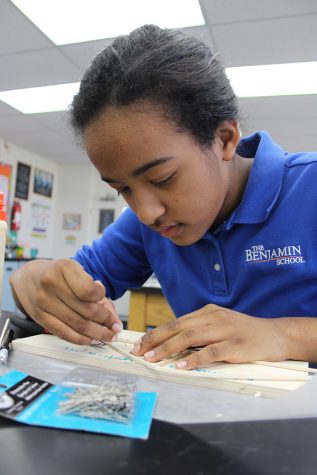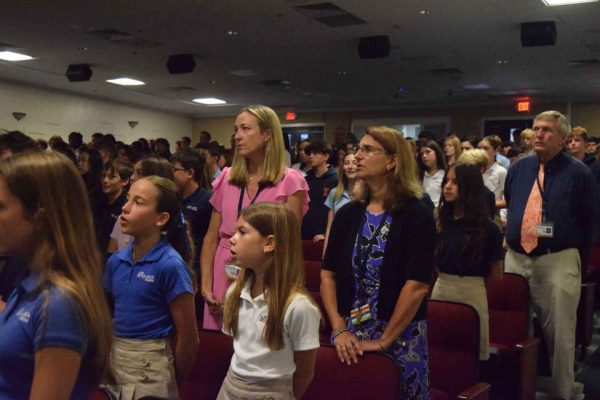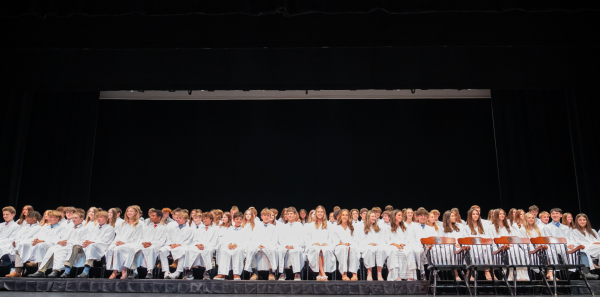The Challenge of Building Bridges
With his bridge in the foreground, eighth grader Carter Stewart conducts research on different types of truss bridges.
Bridges can be annoying – any Benjamin parent or student knows that. Because our campus has bridges to the south and west, many a student has been late to school because one of the bridges is up in order to let boats pass through. However, bridges are more than just a morning annoyance – they are load-bearing pathways that allow people to get where they need to go. For the eighth graders in Ms. St. Martin’s SEAT (Science, Engineering, Analysis, and Technology) class, bridges are more annoying than helpful, but that’s because the students are having to build them on their own.
The students are currently building bridges out of balsa wood, a light-colored and light-weight wood, and testing them to see which can hold the most weight. To begin the process, students chose their design after researching various truss bridges, drawing them on a sheet of paper, or by creating prototypes out of plastic straws and tape, provided by Mrs. St. Martin. Then, students took on creating the final iteration out of balsa wood and carpenters glue.
The students brought in cutting boards, x-acto knives (to precisely cut the wood), and sewing pins (to hold the bridge joints together while the glue dried).
“As I started building my bridge by planning it out on paper, I built the base, and found a truss that was simple, yet strong,” said eighth grader Sebastian Nachilly.

Eighth grader Nichaela Williams attempts to pin together one of her bridge’s joints prior to gluing.
In building these bridges, students are introduced to engineering, a discipline that will serve them well in the SEAT class and beyond. “The purpose of the bridges is to teach preciseness and to be detail-oriented,” said Middle School Science Department Chair Ms. Gabriele St. Martin. [This assignment] then transitions into the Rube Goldberg Project,” explained St. Martin. A Rube Goldberg device is an apparatus that performs a simple task in a complicated fashion. In the SEAT course, St. Martin challenges the students to create such a device to transport a marble from one place to another.
The balsa wood bridge project helps prime the students for the Rube Goldberg assignment, and the students enjoy the engineering aspect of it. “I have always [looked] into being an architect, and the [introduction of the bridges] has shown me that triangles are so useful because of their strength,” said eighth grader Nico Graziotto.
However, building the bridges has been no easy task for many of the students. Because the balsa wood is very soft, it often breaks. In addition, the bridges take a whole 24 hours for the glue to fully dry.
Eighth grader Hudson Hale, who has had to redo his bridge four times, has struggled with building his final design. “[I am having trouble with my] anger management skills, [when my bridge] keeps breaking!” said Hale. “[It keeps breaking] more than I can count!”
For others, working with sharp instruments (or careless students), has proven to be challenging.
“Some people just shouldn’t be trusted with [x-acto] knives, and I hope they know who they are,” stated eighth grader Molly Fried. “The idea of every student having a sharp knife [makes me] very anxious.”
“I almost cut open my leg with my x-acto knife when I dropped it,” added eighth grader Alex Kahn.
Along with the sharp x-acto knives, students also struggle with the sewing pins, where if a student makes a wrong move, that individual may have a broken bridge and a prick on her finger. “The pins can be deadly sometimes, said Kahn.”
Competition is also an issue. Most students want to build their bridges perfectly, which can cause anxiety and stress. “We are self-conscious about our bridges, especially when you work in the same class [with other perfectionists]” said Fried. Added fellow eighth grader Alex Michelon, “I hate it when other students steal your knives and supplies.”
Because of these issues and frustrations, many students are looking forward to testing their bridges, not because they are anticipating their structure holding the most weight, but because they are eager to see their bridges destroyed. “I can’t [wait to break] it because I am tired of building it,” complained Fried.





